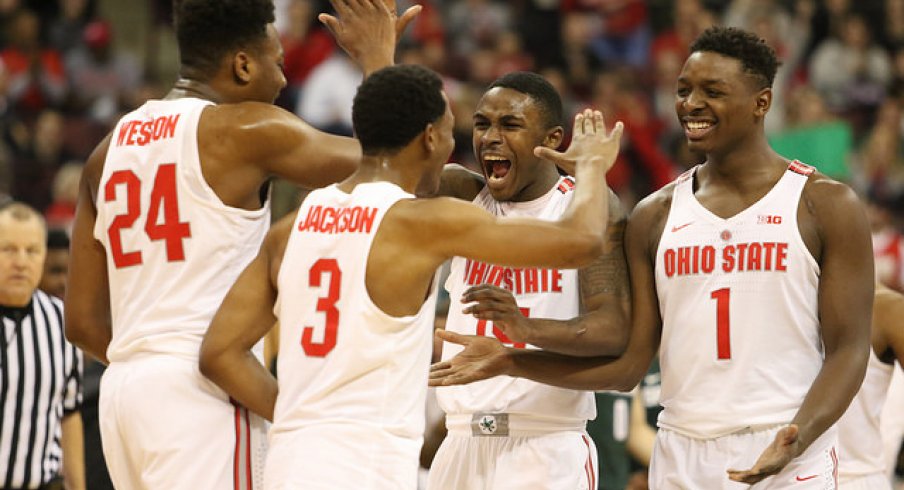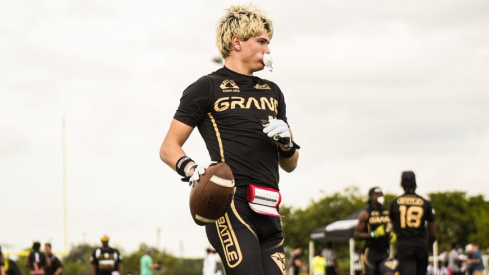The Ohio State basketball program saw an exodus during the offseason as four of five members of its 2015 recruiting class transferred either during or following the season.
The players' departures weren't exactly mourned by the coaching staff. In fact, head coach Thad Matta all but called for them.
"Some of you are going to transfer," Matta said he told his team following its NIT loss to Florida. "You don't know it yet, but whatever you do—don't come see me. Just shoot me a text, because I'm tired of looking at you. And we got rid of some guys we needed to get rid of. We got rid of problems, but we kept solutions."
In addition to those "solutions," Matta also brought in four new players to replace the transfers. We took a look at the production of those newcomers in comparison to that of the transfers to determine if it was, in fact, a case of addition by subtraction.
A.J. Harris vs. C.J. Jackson
| Player | Minutes per game | Field Goals | Three Point | Free Throws | Rebounds Per game | Assists per game | Steals per game | Blocks per game | Turnovers per game | Points per game |
|---|---|---|---|---|---|---|---|---|---|---|
| A.J. Harris (2015-16) | 13.7 | 32-99 (32.3 %) | 16-49 (32.7) | 19-28 (67.9%) | 1 | 1.7 | 0.3 | 0 | 1.0 | 2.8 |
| C.J. Jackson (2016-17) | 19.1 | 58-147 (39.5%) | 26-81 (32.1%) | 37-55 (67.3%) | 2.5 | 2.9 | 0.8 | 0 | 1.3 | 5.6 |
C.J. Jackson and A.J. Harris were used very similarly at Ohio State — a change-of-pace, pass-first, defensive-minded point guard coming off the bench. However, there is one huge difference: size.
At 6-1, Jackson is not exactly a tree, but he's considerably taller than who he came to replace. Harris stands just 5-9, hindering his versatility. He had an impressive vertical which led to a few highlights, but was extremely limited in what he could provide the team.
Jackson's size allows him to be a more effective scorer and rebounder, at least doubling Harris' production in both areas. Harris' main contribution to the team was his on ball defense, but Jackson was arguably better in that area as well, forcing over double the turnovers.
Harris was technically a better three-point and free-throw shooter, and protected the ball slightly better, but the differences in those categories are nearly negligible.
Edge: C.J. Jackson
Daniel Giddens vs. Micah Potter
| Player | Minutes per game | Field Goals | Three Point | Free Throws | Rebounds Per game | Assists per game | Steals per game | Blocks per game | Turnovers per game | Points per game |
|---|---|---|---|---|---|---|---|---|---|---|
| Daniel Giddens (2015-16) | 18.2 | 51-110 (46.4%) | 0-1 (0%) | 25-57 (43.9%) | 3.6 | 0.3 | 0.5 | 1.5 | 1.0 | 3.8 |
| Micah Potter (2016-17) | 14.1 | 43-99 (43.4) | 17-51 (33.3%) | 21-35 (60.0%) | 3.1 | 0.3 | 0.3 | 0.4 | 0.7 | 4.1 |
This really is an apples to oranges comparison since Daniel Giddens and Micah Potter are two very different players, but we're going to make it anyway.
Giddens is a much better interior player. He had drastically more points in the paint, pulled down more boards and had over three times as many blocks as Potter. However, Potter had an added dimension to his game: a jump shot.
Potter sunk 17 three pointers during his first season and shot 33 percent from behind the arc. Giddens, on the other hand, scored nearly all his points from in the paint and only attempted one three pointer (for some reason) in his short Buckeye career. Potter is also a far better free-throw shooter, which is always a plus for a big man.
Since their games are so different, it's hard to positively call one better than the other, but Giddens' style of play closely resembles that of Trevor Thompson. Given that, Potter gets the edge for providing the Buckeyes with a type of player not seen elsewhere on the roster.
Edge: Micah Potter
Mickey Mitchell vs. Andre Wesson
| Player | Minutes per game | Field Goals | Three Point | Free Throws | Rebounds Per game | Assists per game | Steals per game | Blocks per game | Turnovers per game | Points per game |
|---|---|---|---|---|---|---|---|---|---|---|
| Mickey Mitchell (2015-16) | 12.8 | 17-48 (35.4%) | 1-4 (25%) | 12-23 (52.2%) | 2.8 | 0.7 | 0.3 | 0.3 | 1.0 | 2.0 |
| Andre Wesson (2016-17) | 11.2 | 19-52 (36.5%) | 13-37 (35.1%) | 15-28 (53.6%) | 1.2 | 0.3 | 0.2 | 0.2 | 0.6 | 2.3 |
Mickey Mitchell was one of the more versatile players on the roster last season. He played small forward, but regularly took on point guard duties, taking the ball up the floor and making more than a few flashy passes. He was a considerably better rebounder and passer than Andre Wesson in their first years, but he was nowhere near the scorer.
Wesson provided the Buckeyes with offense, inside and out. He scored more points, was a far better three-point shooter and was better from the line.
This one really is a toss up, considering both these players played sparingly and were brought on to develop. However, Mitchell provided nearly no offense to a team that desperately needed scoring while Wesson was a much better scorer. Given how he filled team needs, Wesson gets the slight edge.
Edge: Andre Wesson
Conclusion
Despite the fact that Ohio State finished the season with a considerably worse record than last season and is likely headed back to the NIT, this season's crop of newcomers actually was better than last season's. At the very least, they certainly not worse.
The biggest difference this season was the absence of Keita Bates-Diop, who missed most of the season with a stress fracture in his left leg. Bates-Diop was the team's best scorer and probably most versatile player. If he's on this season's roster, perhaps Ohio State is an NCAA Tournament team.
Obviously, this season was not exactly the outcome Matta and the Buckeyes wanted, but pressing the reset button following last season seemed to be at least slightly beneficial.
NOTE: The 2015 class also included Austin Grandstaff, who transferred midway through the 2015-16 season, and the current freshman class also includes Derek Funderburk, who redshirted this season. Neither were included because there's really no production to compare.


